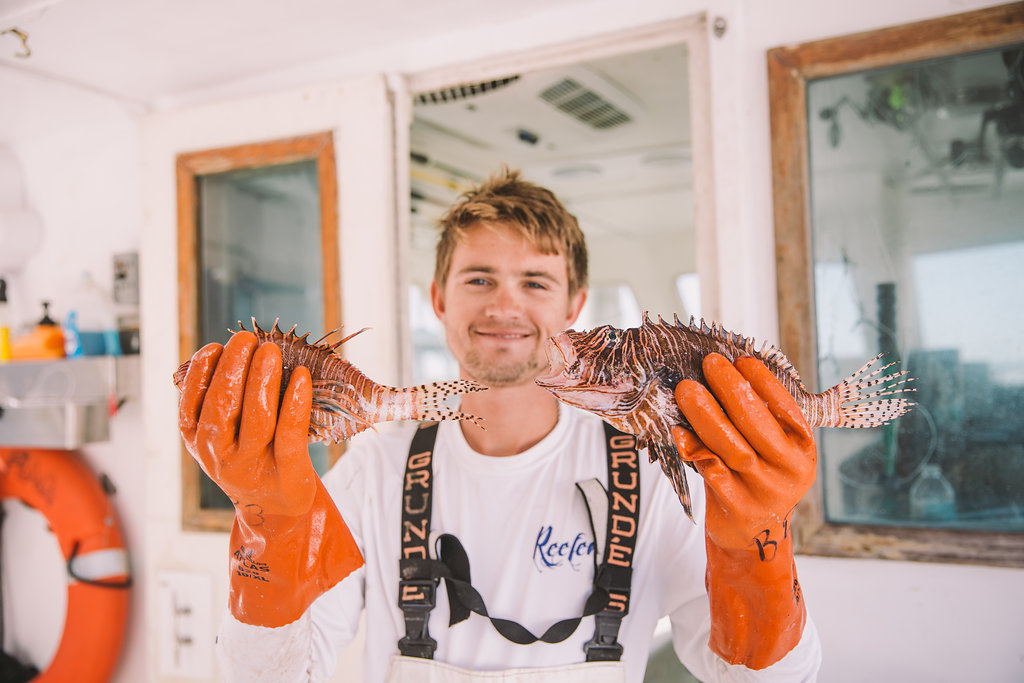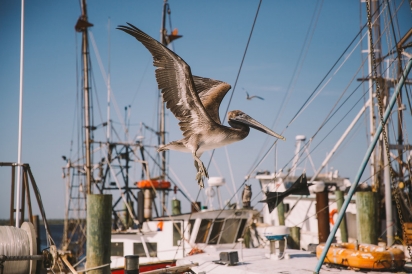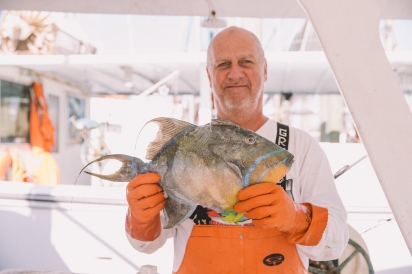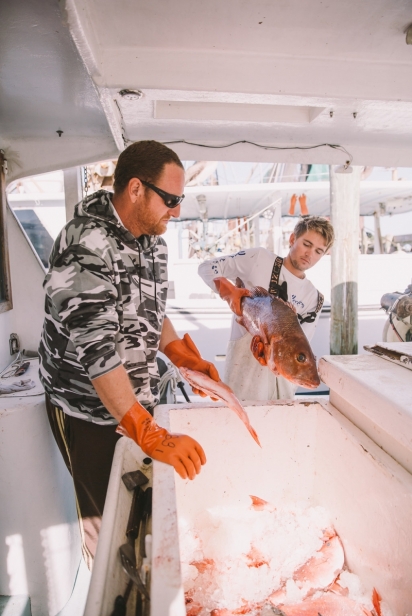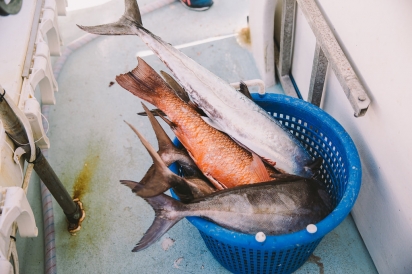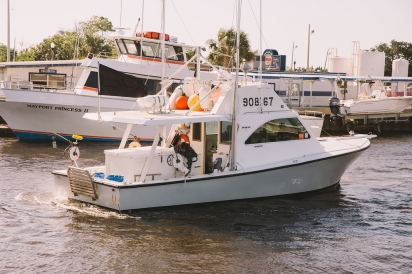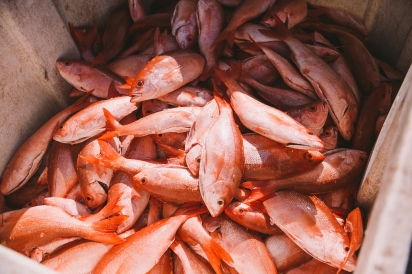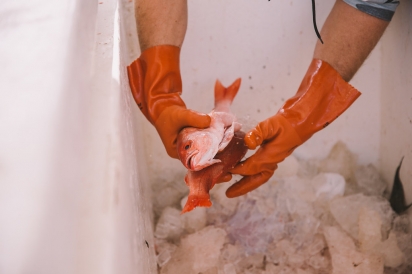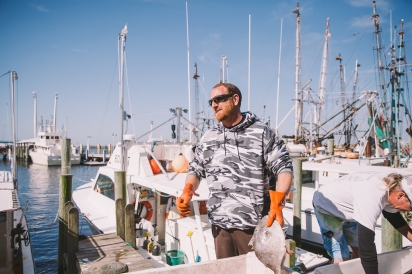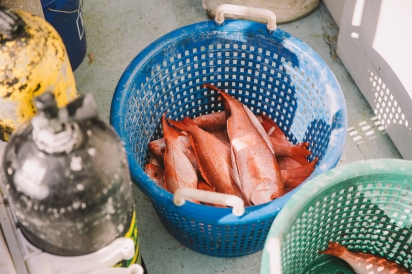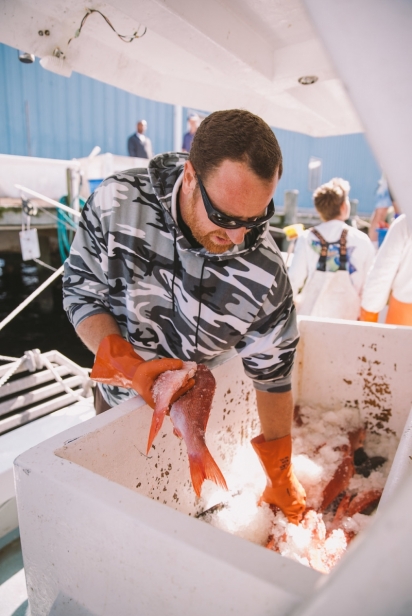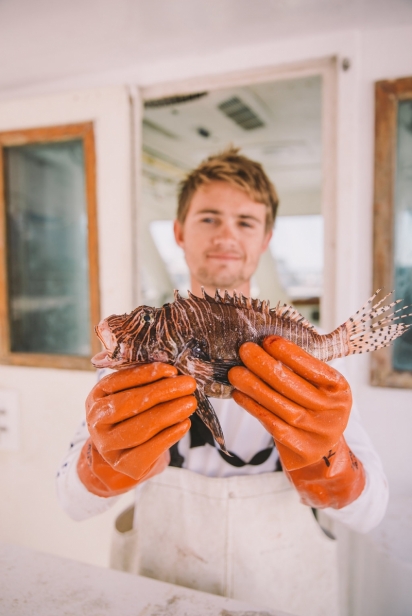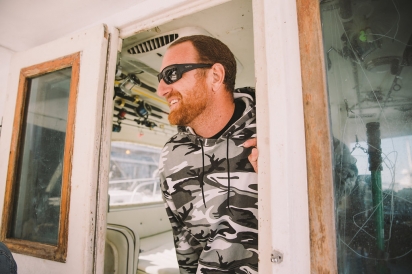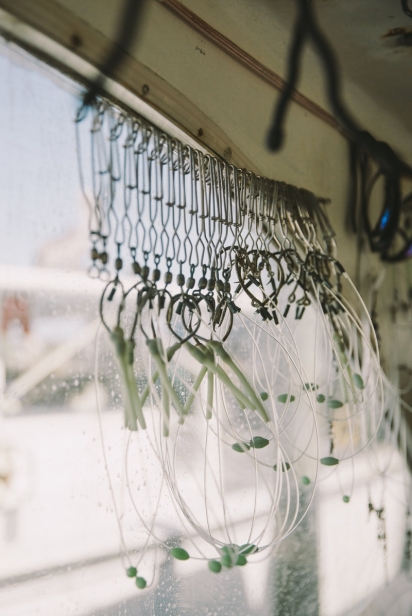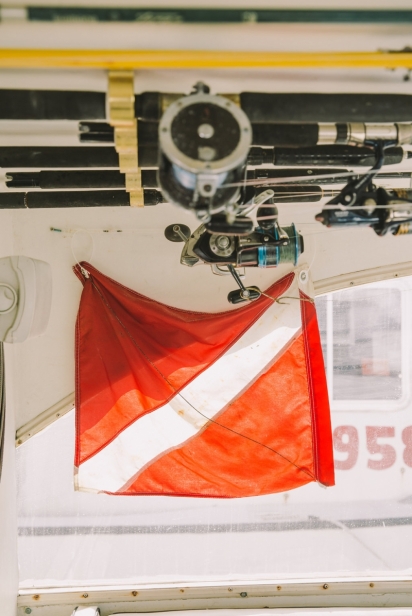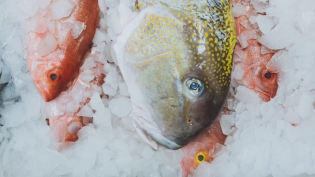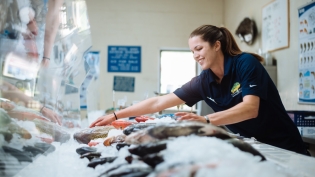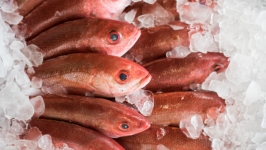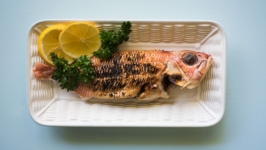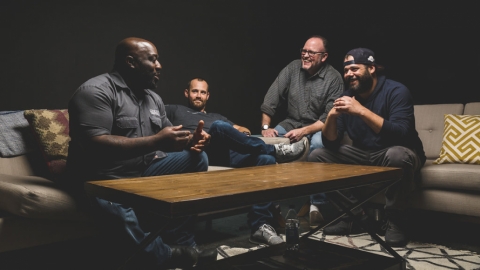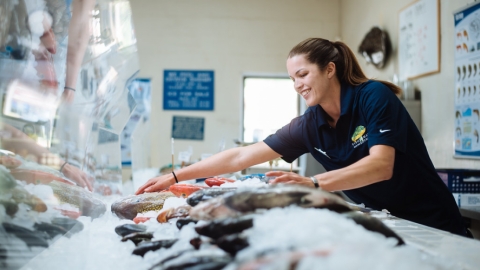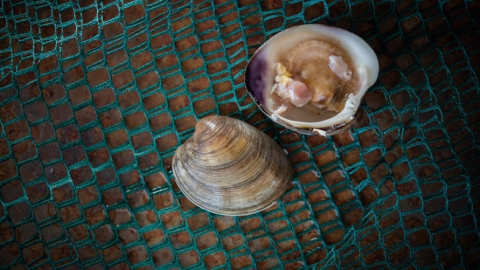Black Flag over a Bountiful Sea
Benny the Butcher carefully backs the Black Flag up to the docks at Mayport’s Safe Harbor Seafood Market & Restaurant and eases it into the slip. Once it’s securely moored, he throws open the hold and inspects the haul — hundreds of pounds of pearly-eyed snapper, along with a few rarer prizes like queen triggerfish, lionfish and barracudas.
As Benny’s crew prepares to toss the fish into baskets and convey them inside to the fishmonger (a market that sells raw fish and seafood), a squadron of hungry pelicans inches closer. Before long, the place will be bustling with seafood lovers who know what the pelicans know. The best, freshest fish on the First Coast comes off boats like Benny’s.
The Black Flag is part of the small but dedicated commercial fishing fleet that operates out of Mayport village. Mayport is best known for its shrimpers, but fishermen are instrumental in bringing in the fresh, seasonal catch that Safe Harbor and its clients rely upon.
On this outing, the primary catch is vermillion snapper, a small and tasty species. During May, when grouper season opens, the crew shifts gears to spearfishing to bag larger, reef-dwelling quarry. Some time after that, they’ll pull up anchor and head to the Carolinas, chasing the seasons and the fish, delivering the bounty of the Atlantic to another harbor town.
Reliance on the seasons sends the Black Flag and her crew all over the Southeast, from Stuart to South Carolina, but the underappreciated quality of First Coast fishing now keeps them in Jacksonville much of the year. “It seems like there’s more fish up here,” Benny said. “Better fishery, more reef, less people.”
Benny the Butcher (whose real name is Benny Bencivenga) has been a commercial fisherman for 6 years. He has the affable, easygoing demeanor of someone who does this recreationally, and he loves the work, but he’s quick to point out that it’s no float down the Ichetucknee.
“The hours are long. It’s a fun job, but it’s a job,” he said. The Melbourne native left a construction career to turn his fishing addiction into full-time employment. “I got into this just for the love of fishing,” he said. “I loved it, and I figured I could make a career out of it.”
Bencivenga’s business partner and co-owner is Steve Nickle, a 32-year veteran of the industry originally from Rockledge, Florida. He also came into commercial fishing in pursuit of a passion. “I was going to college, and I didn’t like it. A buddy of mine asked me if I could pull his blue crab traps for him in the morning. So I started blue crabbing, and I loved it,” Nickle said. He then tried clam diving in the Indian River Lagoon, until pollution and over-harvesting decimated the population. An enthusiastic diver, he took up spearfishing and commercial reel fishing, building a resume that includes virtually everything a fisherman can do in the waters of the Southeast.
Bencivenga acquired the Black Flag in November 2017. The name came with the boat. “Supposedly it’s bad luck to change the name,” said Bencivenga. “Don’t want bad luck 100 miles offshore.” A 39-foot Michael Fitz model, it can haul up to 3,200 pounds, though commercial fishers are only allowed 1,000 pounds per trip. The Black Flag aims for three to five day voyages. “Keeps the fish nice and fresh when we offload them,” Nickle said.
On the Black Flag, fish are put on ice once to kill them, and then, after they’re cleaned, they are iced again for storage. Bencivenga and Nickle sell exclusively to waterfront fishmongers like Safe Harbor, meaning their fish are stored for five days at most. In contrast, industrial operations may freeze fish solid for months before they reach a diner’s plate.
Ocean trips usually involve the two partners and a deckhand. This trip, it’s Crispin Walker, a 20-year-old from Jupiter who, like Nickle, found the ocean more to his liking than college. When Bencivenga posted an Instagram story calling for a deckhand, Walker jumped at the opportunity.
“I’ve always fished all my life, and I just decided I liked it too much not to do it.” Though he doesn’t scuba, Walker brings serious freediving skills to spearfishing excursions. He can stay underwater up to three minutes without tanks. “The deepest I ever went and shot a fish was 100 feet,” he said.
Trips begin by determining when the weather is best for departure. Due to the conditions of the local ocean floor, the Black Flag must travel about 100 miles out, a 10-hour trek. Then, they must find the reefs. The boat has a bottom finder for detecting fish as well as chart plotting equipment, but the process can be tedious. “There’s lots of downtime and lots of driving,” Bencivenga said.
As an independent regional operation, the Black Flag’s fortunes depend entirely on the seasons. The seasons dictate not only what fish can be caught, but what type of fishing is economical. During grouper season, fishermen have an incentive to spearfish heavily, pursuing grouper and other large reef fish. Outside grouper season, the focus shifts to snapper and other smaller fish caught with reels, leaving less time for diving, and therefore often leaving markets short on spearfishing species.
Commercial reef fish licenses authorize both snapper and grouper fishing, but even different types of snapper have different seasons. Mangrove snapper and hogfish can be caught all year, while vermillion snapper have two seasons from January until the national quota is filled, and from July until a second quota is filled. Due to overfishing, commercial red snapper season is determined annually.
For snapper, typically each crew member operates an industrial bandit reel, which can carry up to five hooks at once. When the current is weak, bites are hard to detect on heavy-duty reels, and they switch to fishing poles. Snapper are a major target as they are abundant, and their soft, moist texture and mild flavor is in demand throughout the year. Fish caught alongside snapper include bluefish, barracuda and the odd wahoo.
Other fish are more strictly bound by seasons. Cobia, for instance, only pass through North Florida waters twice annually during migrations between the Carolinas and the Florida Keys. “They’ll be here for three weeks, and then you won’t see them,” said Nickle. Flounder come heavier in February and the summer, following food and weather. Grouper stay put, but they’re protected. Their season runs from May 1 to January 1 and closes earlier if national quotas are reached. Similarly, amberjack season is closed for April and from December to March.
Grouper are popular as they are mild like snapper, but with a firm, though moist and flaky texture. The crew usually catches them with spearguns, which requires diving. It’s a more laborious process, but size matters. “Instead of catching these 2- to 4-pound fish, we’re shooting 15- to 30-pound fish,” Bencivenga said. Spearfishing is also more efficient. “We shoot only what we keep, there’s no bycatch, no unnecessary killings.”
Other spearfishing targets include queen triggerfish, flounder and lionfish. Introduced by humans, lionfish are highly invasive. They multiply like calculators, eat everything on the reef and have no natural predators. “They’re out of control,” Walker said. “That’s why these guys go down there and shoot them all.” Indeed, the state encourages fishermen to spear as many as they can, something the Black Flag crew do with great relish.
As it turns out, too, lionfish are delicious, with white, flaky and tender meat. Though increasingly popular on menus in South Florida, lionfish are still catching on in the north, partly due to their venomous reputation. But Bencivenga tells customers not to worry. Only the spines carry venom, and fishermen clip them before selling. The meat is perfectly safe. Indeed, they’re one of Benny’s favorite meals, “Any way — ceviche, grilled, poached, fried … even sushi. They’re delicious.” After a few days onshore, the Black Flag will head out for another trip, if the weather gods consent. “Whenever the weather’s good, we have to go,” Bencivenga said. “Because sometimes in the wintertime, we can’t fish for 30 days since the weather’s so rough.”
The true price of fresh, seasonal fish is uncertainty — uncertainty for the fishermen who must navigate the capriciousness of the weather and the ocean, and uncertainty for the customers who can’t be sure stores will have their favorites. But once you’ve tasted a vermillion snapper fresh off the Black Flag, grilled up with a little butter, flaking off your fork and melting on your tongue, you’ll know it’s worth the price.


